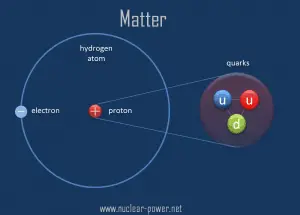 Quarks are a type of elementary particles and fundamental constituents of matter. In the quark model, all hadrons are made of a few quarks. The quark theory is well-accepted today, and quarks are considered fundamental particles.
Quarks are a type of elementary particles and fundamental constituents of matter. In the quark model, all hadrons are made of a few quarks. The quark theory is well-accepted today, and quarks are considered fundamental particles.
Properties of Quarks
Besides charge and spin (1/2 for the baryons), two other quantum numbers are assigned to these particles: baryon number (B) and strangeness (S). Baryons have a baryon number, B, of 1, while their antiparticles, called antibaryons, have a baryon number of −1. A nucleus of deuterium (deuteron), for example, contains one proton and one neutron (each with a baryon number of 1) and has a baryon number of 2.
Electric Charge of Quarks
The most familiar baryons are the proton and neutron, each constructed from up and down quarks.
The proton has a quark composition of uud, and so its charge quantum number is:
q(uud) = 2/3 + 2/3 + (-1/3) = +1
The neutron has a quark composition of udd, and its charge quantum number is therefore:
q(udd) = 2/3 + (-1/3) + (-1/3) = 0
Since the neutron has no net electric charge, it is not affected by electric forces, but the neutron does have a slight distribution of electric charge within it. This is caused by its internal quark structure. This results in the non-zero magnetic moment (dipole moment) of the neutron. Therefore the neutron also interacts via electromagnetic interaction but is weaker than the proton.
Mass of Quark
The mass of the neutron is 939.565 MeV/c2, whereas the mass of the three quarks is only about 10 MeV/c2 (only about 1% of the mass-energy of the neutron). Like the proton, most of the mass (energy) of the neutron is in the form of the strong nuclear force energy (gluons). The quarks of the neutron are held together by gluons, the exchange particles for the strong nuclear force. Gluons carry the color charge of a strong nuclear force.
Therefore, we have to distinguish between current quark mass (also called the mass of the ‘naked’ quarks) and constituent quark mass. Current quark mass refers to the mass of a quark by itself, while constituent quark mass refers to the current quark mass plus the mass of the gluon particle field surrounding the quark.
Noteworthy, because most of your mass is due to the protons and neutrons in your body, your mass (and therefore your weight on a bathroom scale) comes primarily from the gluons that bind the constituent quarks together rather than from the quarks themselves. Mass is primarily a measure of the energies of the quark motion and the quark-binding fields of any real object. It must be noted that gluons are inherently massless. They possess energy.